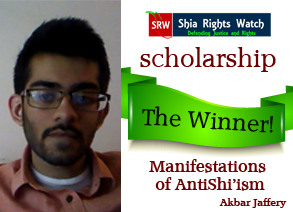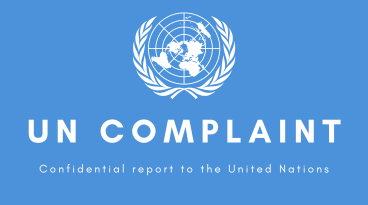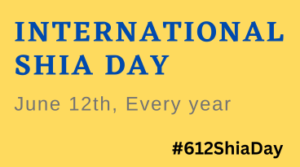
Shia Rights Watch 2015-16 Scholarship
Shia Rights Watch is proud to announce the recipient of another Anti-Shiism scholarship. Akbar Jeffrey’s paper,”Manifestations of antiShi’ism”, is selected as the winning paper.
The Anti-Shiism scholarship was established in 2014 to increase awareness and understanding of the targeting of the Shia minority all over the world. We hope this The tuition assistance encourages students of all disciplines to continue higher education and make scholarly contribution to the field of minority rights.
Akbar Jaffery is 20 year old from the suburbs of Chicago. He will be a junior at the University of Illinois at Chicago starting Fall 2017. His major is Political Science and Economics and hopes to pursue Law degree.
Shia Rights Watch congratulates Akbar Jeffery on his award and wishes him the highest achievements.
Manifestations of AntiShi’ism
Akbar Jaffery
5/12/16
Shi’a history has consistently been characterized with vehement and at times, violent opposition, only finding a handful of periods to unfold without the guiding force of state or communal terror such as tenthcentury Buyid (Persia) and 18th century Nawabi Awadh (India) rule. Barring these two examples among other kingdoms and dynasties with Shi’ism as a state religion, others reflect Shi’a history as a history of suppression suppression which has evoked an interest in Shi’a history among scholars directly following the 1979 Iranian Revolution, attempting to put to rest American and Western notions of Shi’ism as a religion of radicalism (Fuller, Francke 1999).
This interest has only increased in recent decades: various Shi’a organizations have started to reach out to the West for their voice to be heard following the recent wave of antiShi’a violence in Pakistan, the Bahrain government’s suppression of protests, and a rare attack targeted against the Shi’a of Kuwait in June 2015. When explaining worldwide antiShi’a sentiment, the Shi’a will often broadly interpret it in terms of violent sectarianism. This is a very simplistic approach and only touches one aspect of many different factors in which antiShi’a sentiment may manifest itself across numerous countries.
This paper examines government fears and terrorist objectives that move beyond emotions of hatred of the Shi’a, in hopes that a proper identification of the problem will assist in forming appropriate solutions to offer greater security to the Shi’a in their respective countries.
Such an examination necessitates an understanding of the Shi’a, their origins, and their early history as distinct from the Sunni school of thought. As examining the split between both traditions is beyond the scope of this paper, it suffices to say there exists a vast array of literature on the topic, and while many Sunni and Shi’a view their beliefs as being expressed and established as the orthodox during the Prophet Muhammad’s life, there exists a general consensus among historians that Shi’ism was merely a preference or leaning prior to the advent of the Abbasids in the mid-8th century.
Najam Haider challenged this notion in The Origins of the Shi’a by highlighting a protoShi’a strand present earlier into the 8th century in Kufa, Iraq. Above all, both traditions evolved concurrently. Unlike the Christian splintering off of sects with an established orthodox, writes Omid Safi, “in spite of the frequent association of “orthodox” with Sunni interpretations of Islam, it is a mistake to identify Islamic orthodoxy with either the Sunni or Shi’a tradition” (Safi 2009: 25859).
While both traditions evolved synchronously, they nevertheless considered their respective foundations Islamic orthodoxy, thus heretical beliefs of certain protoShi’a groups characterized much of the Sunni heresiographical works, most famously alShahrastani’s Kitab alMilal wa alNihal. AlShahrastani’s Kitab vilified the roots of Shi’ism proper in accordance with the prophetic narration of the Islamic ummah[1] splintering into 73 sects, where only one is to be saved on the Day of Judgment.[2]
While the earliest examples of heresiographical literature address the Ash’ari and Mu’tazili traditions within Sunni Islam, the first extant work encapsulating differences between sects understood today is Abu Mansur alBaghdadi’s (d. 1037) Farq bayn alFiraq. After describing the beliefs of various groups, he reaches the conclusion that the saved group (alFirqa alNajiya) is none other than the Ahl alSunnah wal Jama’ah[3] (Thomas: 226229).
Although alBaghdadi was primarily an 11th century scholar, the beliefs of specific protoShi’a and Shi’a groups were well known among 10th century Sunni scholars. Abu Hayyan alTawhidi, an influential Sunni thinker of 10th century Baghdad, harshly criticized the Shi’a doctrine of bada’[4] which he correctly ascribed to the Kaysaniyya sect, and beliefs of other extremist protoShi’a individuals and groups, such as anthropomorphism and metempsychosis (alQadi 2003: 147).
Shi’a theology, including beliefs that were held by certain groups at certain periods of time, thus characterize a general Sunni antagonism towards Shi’ism.
Sunni scholars in following centuries continued to similarly expound on various beliefs of the Shi’a which they viewed as heretical, oftentimes conflating the beliefs of various Shi’a sects. In the 13th century, Ibn Taymiyyah wrote his Minhaj alSunnat alNabawiyyah fi naqd kalam alShi’at alQadariyyah, in which he berates the ghulat (exaggerator) theologies, Ismailism, and popular Twelver Shi’ism, “ignoring the important doctrinal and practical differences between various Shi’a sects” (Dabashi 1988: 75), in hopes of popularizing the belief of their disbelief. A simple argument offered by one of Ibn Taymiyyah’s renowned students, Ibn Qayyim alJawziyyah, brings to the fore a narration in which the Prophet Muhammad is reported to have claimed he accepts the Muslim ummah as long as the ummah is accepted by his companion Ibn Mas’ud. Extending Ibn Mas’ud to represent the entire body of the Prophet’s companions, Ibn alQayyim concludes to oppose a single companion is tantamount to opposing the Prophet (Bell 2003: 202).
Arguments such as Ibn alQayyim’s were formed by Sunni scholars over centuries to ostracize the Shi’a across the Muslim world where Sunni Muslims formed the rulership, aristocracy, and majority.
However, animosity against the Shi’a does not only stem from theological differences.
During the 8th to the 11th centuries, the rulers of the Islamic domain too wished to ostracize the Shi’a, not only because the clergy they surrounded themselves with opposed Shi’ism in theory, but because the rise in ‘Alid revolts became a burden for the ‘Abbasid caliphs. Opposition to Shi’ism began to carry ‘Abbasid fears of losing power and influence following the revolts of Muhammad alNafs alZakiyya (d. 762), Hussain b. ‘Ali (d. 786) and Abu alSaraya (d. 815).
These ‘Alid revolts resulted in measures to prevent future dissent. One such measure was the Caliph alMa’mun’s naming of the eighth Twelver Shi’a Imam, ‘Ali b. Musa alRida, as his heirapparent following the revolt of Abu alSaraya, generally spoken of as an attempt by alMa’mun to reconcile the ‘Abbasids and ‘Alids (Buyukkara 2002: 44546).
The other tactic was to keep the Shi’a Imams under close watch or house arrest, as was the case with the ninth, ‘Ali alHadi and eleventh, Hassan al‘Askari; the seventh Twelver Imam, Musa b. Ja’far alKazim, was kept imprisoned. The imprisonment and close watch of later Twelver Imams played a great role in the shaping of a Shi’a psyche, understanding their history as one of persecution which fits into their memory of dispossession starting with the first Imam, ‘Ali b. Abi Talib.
This trend of opposing the Shi’a to maintain one’s power can be seen in contemporary situations where the Shi’a unanimously feel they are, or have been, persecuted by the ruler(s) of their respective countries, most notably where the Shi’a form an absolute majority Bahrain and Iraq. In order to sustain their Westernbacked minority rule, various methods have been adopted by the rulers of these two countries ranging from fascism veiled as secularism, to blatant antiShi’a state persecution.
As a great proponent of the former, Saddam Hussein maintained his nearly 25 year long regime through claims of upholding secularism. Infamous for his suppression of Iraq’s Kurdish minority and Shi’a majority, his terror was easily sustained with the guise of secular Ba’athism[5]. Militant Arab nationalism of the early 20th century served Ba’athist interests following its successful coups in the 1960s. British support of Sunni military officers propping the Kingdom of Iraq following World War I set the overlap of Sunnism with military authority and state formation, an association consolidated following Iraq’s independence. While the first Ba’ath coup brought several Shi’a members into its Regional Command, there was not a single Shi’a by 1970 (Fuller, Francke: 97).
Ba’athism’s failure to include Iraq’s Shi’a majority is indicative of how entrenched identities and recollections of Sunnism are within the wider scope of Arab history.
This sense of Arabism, accompanied with antiPersian rhetoric, heightened following the 1979 Iranian Revolution. Associated with Safavid Iran for centuries, one of the oftrepeated criticisms of Shi’ism is being a Persian conspiracy to undermine the strength of the Arab Muslim ummah (Fuller, Francke: 19).
Thus in addition to characterizing Shi’a demands as sectarian and divisive to weaken the secular state, Saddam and his Ba’athists easily revived archaic notions of Shi’a loyalty to the Persians and its latest benefactor, postrevolution Iran. Instead of using its secular, nationalist manifesto to shape a state where all religious and ethnic groups take part in guiding it, the Iraqi Ba’ath party reflected panArab notions of glorifying Arab cultures in which the role of Shi’ism and Shi’a individuals are denigrated or outright ignored, in turn reinforcing the same sectarianism which plagued the Middle East for centuries. “There was no talk of sectarianism in pre2003 Iraq,” says Dr. Abbas Kadhim, “Shias who dared speak of sectarianism would have their tongues cut out,” aptly describing the reality of these decades in Iraq’s history while condemning the mistaken notion of sectarianism being sowed only after the 2003 invasion of Iraq.
While Saddam’s Iraq reflected mainly Shi’a persecution veiled behind secularism, there also exist examples where Shi’ism was openly lambasted and dealt with violently. Alongside closing the Shi’a religious institutions in the shrine cities of Karbala and Najaf, Saddam’s executions and kidnappings of individuals from renowned Shi’a families reflects the violent repression of Iraq’s Shi’a. Kidnappings reached their peak following the 1991 uprising where 96 members of the scholarly alHakim and 28 of the Bahr alUlum families were kidnapped and likely executed (Fuller, Francke: 99).
Similarly, following the 1991 uprising, state newspapers and publications were distributed which openly villainized the Shi’a as treacherous for their beliefs (Fuller, Francke: 104).
A similar response to Shi’a activism is currently present in Bahrain, another Shi’amajority country ruled by the Kuwaiti Sunni descent alKhalifa family who migrated to the country in the late 18th century and received legitimization from the British crown. Distinctly Shi’a since Abbasid rule, Bahrain was ruled by the Safavids for the entirety of the 17th century and became a power vacuum where several forces fought for power over the island, resulting in the alKhalifa establishing its rule. The Shi’a formed such a vast majority at the time of the invasion that the alKhalifa family invited tribes native to Saudi Arabia to further displace the Shi’a. A total of 313 Shi’a villages prior to the alKhalifa invasion were eventually reduced to 50 by the time of Fuller and Francke’s study in 1999 (121). Not only have Bahrain’s Shi’a been internally displaced to one specific section of the island, they are barred from land ownership, the military, and supreme ministry offices (Rabi 2012: 207). It was only in 1928 when the Shi’a rebelled against a feudal system which required uncompensated labor without any guaranteed civil rights (Fuller, Francke: 122).
A collective memory of subjugation to the alKhalifa in feudal Bahrain leaves the Shi’a widely calling for democratization, a trend later to be detailed among the Shi’a of Saudi Arabia. The earliest democratic movement is the Shabab alUmma[6], established in the mid1930s by both Bahrain’s Sunni and Shi’a populations. Shi’a activism in the early 1970s resulted in the country’s first parliamentary elections following independence from Britain in 1973, only to be dissolved by the alKhalifas two years later for refusing to pass a law sponsored by the regime that “authorized arrest and imprisonment of up to three years without charge or trial for undefine ‘acts’ or ‘statements’ that could be construed to threaten the country’s internal or external security” (Fuller, Francke: 125).
Contemporary Bahraini demands include, at the least, a proper implementation of the 1973 constitution by reestablishing Bahrain’s parliament.
Democratization, however, is not in the interests of the alKhalifa family. Following Bahrain’s discovery of oil in 1932, the state became independent of local merchant support resulting in a shift to greater authoritarianism, as observed in the dismissal of the 1973 parliament. The mid to late 20th century witnessed state recognition of Shi’a practices: permitting their practice of law as distinct from Sunnism, and allowing greater legal protection in order to appease Bahraini Shia demands and offer personal security to its largest labor force demographic in order to balance this shift to greater authoritarianism (Rabi: 208).
By acceding to the Shi’a these privileges, the alKhalifas portray any further demands in a negative light.
Indeed, any demand for democratization is perceived by the state as a threat to the established order (Fuller, Francke: 119).
Two final examples serve to remind that at times, persecution of the Shi’a truly stems from the books. While Saddam in Iraq and the early alKhalifa invaders found it useful to vilify the Shi’a on theological grounds to sustain their rule, some contemporary examples exist in which the Shi’a have been subject to violence and persecution with utmost regard to the rulings of historical Sunni theologians in upholding the heresy of Shi’ism. As a result, Saudi Arabia is the only country in the world today with de jure discrimination of its Shi’a population. It is the only country where the Shi’a are legally considered nonMuslim through edicts of the Aal alSheikh. Such modern takfir[7] has been pronounced by Saudi scholars since 1927, and was reasserted by Council of Senior Scholars member ibn Jibrin in 1991 when he declared the disbelief of Shi’a Muslims, through which their murder cannot be held illegal (Fuller, Francke: 183).
De jure discrimination against the Shi’a, who primarily hail from the eastern region of alHasa8, is linked to the House of Saud’s connection with the Aal alSheikh which, since the establishment of Saudi rule, has maintained the House of Saud’s legitimacy to rule the country. When Abd alAziz, the House of Saud’s progenitor set out to conquer Arab lands in the early 19th century, the reformist ideology of Abd alWahhab assisted in justifying his previous raids as raids in the name of Islam. A 1744 pact between Abd alAziz and the descendants of Abd alWahhab allowed each family to legitimize the other in their expertise; the former would establish the state, and the latter would legitimize its rule through its religious credentials. This first Saudi state quickly collapsed however, and it was not until the fall of the Ottoman Empire that the second Saudi state was formed by Abd alAziz ibn Saud in the early 20th century (Crooke).
Following the 1913 defeat of the final Ottoman garrison in alHasa at Saudi hands, the Shi’a of the region complied with Saudi rule but quickly became subject to scholarly demands of their forced conversion or murder in the 1920s. Saudi rulers reined in these extreme voices, stopping short of genocide, but continued to ban all public Shi’a commemorations and institutions including mosques (Jones 2012: 138).
AntiShi’ism in Saudi quickly became far reaching: Sunni citizens are instructed not to eat meat slaughtered by the Shi’a, the Mutawwa’in (moral police) often harass the Shi’a in public, and keeping Shi’a literature in one’s home is considered a criminal act. Grade school curriculums are standardized to rebuke Shi’a beliefs and teach children from a young age, Sunni and Shi’a alike, that the Shi’a are a heretical group. (Fuller, Francke: 18385)
The Shi’a in Saudi Arabia, like the Shi’a in Bahrain, have called for more freedom and reform of their country for decades. Politicization of the Shi’a in the 1950s and 1960s through employment in ARAMCO resulted in the 1979 protests defying the Saudi ban on Muharram processions in Qatif. These demonstrations spread from Qatif to other cities in alHasa until finally being restrained by the government (Jones: 141). Leaders of this uprising formed the Organization for the Islamic Revolution in the Arabian Peninsula (OIR) and adopted revolutionary tactics which pressured the Saudi government to accede to Shi’a demands to an extent, such as establishing the first modern hospital in Qatif in 1987. By the late 1980s however, the OIR recognized its revolutionary rhetoric would not produce fruitful results, and so shifted its focus to human rights and equal citizenship. Such demands reflect the trend of calls for democratization made by the Shi’a of Iraq and Bahrain.
In 1994 the Saudi regime invited OIR expats back to the country in hopes of reconciliation but were unable to meet many core demands made by the Shi’a which contradicted the state’s Wahhabi ideology, such as the freedom to publish and possess Shi’a literature, and the establishment of Shi’a mosques and seminaries (Fuller, Francke: 191).
Unlike the Shi’a of Iraq and Bahrain however, the Shi’a of Saudi Arabia hesitated to raise their voice and demands of democratization until recent decades. Those who demand democratization of Saudi Arabia today, as seen following the 201112 protests, become subject to the state’s brute force. Shi’a leader Sheikh Nimr Baqir alNimr’s January 2016 execution exemplifies how the Saudi state is at pains to conflate calls for democracy with terrorism.
Executing alNimr and three other Shi’a alongside dozens of alQaeda members reaffirms for Saudi nationals the “impartiality” of the government when punishing those who question its legitimacy. It also provides the foundation for ruling families intricately tied to Saudi, such as the alKhalifas in Bahrain, to continue arresting Sunni and Shi’a activists alike under clauses in its constitution which criminalize ridicule or criticism of brotherly countries.
Finally comes Pakistan, which stands out among other examples of Shi’a persecution: while the previously examined countries all involve antiShi’ism arising from the state as part of an ideology or consolidation of Sunni power, the problem of Pakistan is that individuals ideologically opposed to Shi’ism exist at alarming rates who wish to see statewide takfir of the
Pakistani Shi’a. This segment of the Pakistani population organized itself under a political body, initially known as the SipaheSahaba (Army of Muhammad’s Companions). Established in 1985, this outfit is currently on the Interior Ministry’s list of banned terrorist organization and thus reorganizes itself under various names when campaigning: most recently it has identified as the Ahl alSunnat wal Jama’at (ASWJ) and Pakistan RaheHaq Party (Path of Truth Party Pakistan). Instead of taking action against its sectarian demands and divisive rhetoric however, the party and its demands have been mainstreamed by major political parties. The antiShia vote is essential in many constituencies, thus political parties often form alliances with extremists and permit them immunity from law enforcement agencies in return for votes. Even political parties such as the Pakistan People’s Party (PPP), which is reputed for including both Sunni and Shi’a members among its upper echelons, have struck deals with SSP members. During the turbulent antiShi’a atmosphere of the 1990s, Benazir Bhutto’s PPP appointed the SSP’s Sheikh Hakim Ali as Minister of Fisheries in Punjab, and another SSP leader, Azam Tariq, was allowed immunity from law enforcement as it benefited Bhutto to counter Shi’a individuals from her own party native to Punjab (Grare 2013: 139).
After General Pervez Musharraf dismissed Prime Minister Nawaz Sharif in a coup a decade later, he suspended the constitution and banned the SSP as a sectarian outfit involved in relentless antiShi’a violence throughout the late 1990s. To maintain popularity among this demographic however, he permitted Azam Tariq in 2002 to contest elections from prison as an independent candidate provided he support the regime (Kalia 2015).
Although Pakistan, while created for Muslims, was not intended by its creators for any one sect to use as a machine to propagate and impose its beliefs instead to manufacture a sectless political identity, violence was not unheard of; Pakistan’s first ShiaSunni riots occurred in Punjab during the 1950s (Punjab Disturbances Court of Inquiry, 1954: 34).
A significant example, the Thehri, Khairpur massacre of 1963 in which 116 Shi’a Muslims were killed on the holy day Ashura serves to disprove notions that antiShi’a sentiment was imported from abroad, generally explained by Salafi thought. Salafi thought neither has a footing in Sindh, nor in the antiShi’a militant groups born in Punjab; rather all examples of antiShi’ism in Pakistan are attributed to the 19th century revivalist Indian Hanafi movement, the Deobandi movement. Literature of both the Deobandi and the more wellreputed as well as populous Barelvi movements are laden with antiShi’a rhetoric and even declarations of their disbelief[8].
Although these rulings were largely discarded for decades of Pakistan’s existence, the surge in organized antiShi’a movements during the 1980s General ZiaulHaq regime, which sought to establish a bulwark against growing Shi’a activism following the Iranian Revolution, greatly benefited from this vast corpus to demand statewide takfir of the Shi’a and mobilize violence. The policies of Zia, Bhutto, and Musharraf detailed above exemplify what has remained standard Pakistani policy with regard to antiShi’a outfits, both at the provincial and federal levels.
Two examples of antiShi’ism addressed in this paper reflect attempts to discriminate against majority Shi’a populations to consolidate power in one family and/or within a Sunni elite. In response to this, the Shi’a of Bahrain and Saudi Arabia understand themselves to be protesting for developments and propagation of values which transcend sectarian goals and are at pains to disassociate their movement from inwardlooking activism.
The remaining two examples exhibit the intensity of theological opposition to the Shi’a, how such antiShi’ism as state ideology devastates Shi’a communities, and how in certain cases the state does not even need to advocate antiShi’ism; rather the population at large can organize itself in antiShi’a groups and wreak havoc. In such situations, state policy should be directed towards preventing the militarization of such ideology if the ideology itself cannot be erased. It is my hope that these examples highlight how suppression of the Shi’a is not only a result of unadulterated hatred of Shi’ism, but rather manifests itself differently in different situations, and that understanding these specifics will help policymakers solve the crisis of antiShi’ism in accordance to each situation.
Works Cited
AlTirmidhi, Abu Isa Muhammad. Jami’at AlTirmidhi. Vol. 5. N.p.: n.p., n.d. Sunnah. Web.
Buyukkara, M. Ali. “AlMa’mūn’s Choice of ‘Alī AlRiḍā as His Heir.” Islamic Studies 41.3
(2002): 44566. JSTOR. Web. 12 May 2016.
Crooke, Alastair. “You Can’t Understand ISIS If You Don’t Know the History of Wahhabism in
Saudi Arabia.” The Huffington Post. TheHuffingtonPost.com, 27 Oct. 2014. Web.
Fuller, Graham E., and Rend Rahim Francke. The Arab Shiʼa: The Forgotten Muslims. New
York: St. Martin’s, 1999. Print.
Grare, Frédéric. “The Evolution of Sectarian Conflicts in Pakistan and the EverChanging Face of Islamic Violence.” CSAS South Asia: Journal of South Asian Studies S. Asia: J. of S.
Asian Stud. 30.1 (2007): 12743. Web.
Haider, Najam Iftikhar. The Origins of the Shīʻa: Identity, Ritual, and Sacred Space in
Eighthcentury Kūfa. New York: Cambridge UP, 2011. Print.
Kalia, Ravi. Pakistan’s Political Labyrinths: Military, Society and Terror. N.p.: n.p., n.d. Print.
Khan, Ahmed Raza. AhkameShariat. N.p.: n.p., n.d. Ala Hazrat. Web.
Madelung, Wilferd, Farhad Daftary, and Josef W. Meri. Culture and Memory in Medieval Islam:
Essays in Honour of Wilferd Madelung. London: I.B. Tauris, 2003.
Moghadam, Assaf. Militancy and Political Violence in Shiism: Trends and Patterns. Milton
Park, Abingdon, Oxon: Routledge, 2012. Print.
Munir, Muhammad. Report of the Court of Inquiry Constituted under Punjab Act II of 1954 to
Enquire into the Punjab Disturbances of 1953. Lahore: Supt., Govt. Print., Punjab, 1954.
Web.
Nasr, Seyyed Hossein., Hamid Dabashi, and Seyyed Vali Reza Nasr. Shiʻism: Doctrines,
Thought, and Spirituality. Albany: State U of New York, 1988. Print.
Safi, Omid. Memories of Muhammad: Why the Prophet Matters. New York: HarperOne, 2009. Print.
[1] The worldwide community of Muslims
[2] Jami’at alTirmidhi, Hadith 2641
[3] “People of the Sunnah (Muhammad’s custom) and the Community”
[4] Bada’ is the belief in alteration of the divine will. Although originating in the Kaysaniyya it was later upheld by later Twelver Imams in justifying the selection of imams following succession crises (see Haider, Shi’i Islam: An
Introduction, p. 93).
[5] Ba’athism is a panArab movement which seeks to create a unified Arab state with socialist economics, it has often been characterized as a fascist movement.
[6] “Youth of the Community”
[7] Scholarly accusations of entire groups apostatizing from what is considered to be true Islam. Scholarly assertions on the disbelief of Shi’ism has a historical place in Sunni literature as previously shown in heresiographical works. 8 Renamed ashSharqiyyah (Eastern Province) which is perceived by its Shi’a to be an example of cultural discrimination to erase Shi’a culture.
[8] Khan, Ahmed Raza. AhkameShariat, Problem 85.








